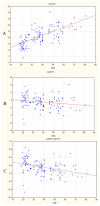The Importance of Orthostatic Increase in Pulse Wave Velocity in the Diagnosis of Early Vascular Aging
- PMID: 39407773
- PMCID: PMC11476871
- DOI: 10.3390/jcm13195713
The Importance of Orthostatic Increase in Pulse Wave Velocity in the Diagnosis of Early Vascular Aging
Abstract
Background/Objectives: Vascular aging can be assessed by arterial stiffness measured through pulse wave velocity (PWV). Increased PWV predicts arterial hypertension, cardiovascular events and all-cause mortality. Detection of early signs of vascular aging remains an unmet problem. To search for the most sensitive markers for the early increase in vascular stiffness in a healthy population. Methods: One-hundred and twenty healthy subjects were divided in three equal age groups: <30 years, 30-45 years and >45 years. Head-up tilt test (HUTT) protocol was applied, providing a standardized hydrostatic column height. PWV at the brachial-ankle artery site (baPWV) was measured using a multichannel sphygmomanometer ABI System 100 PWV in three positions: in the baseline horizontal (supine) position-baPWVb; during the head tilt-up with an individual angle of inclination-baPWVt; and when returning to supine. Results: The most sensitive marker of early stiffness increase in a healthy population is the relative orthostatic increase in baPWV, ΔbaPWV/baPWVb, where ΔbaPWV = baPWVt - baPWVb. The significance of differences in this parameter between the young and elderly groups reached p = 0.000075 and p = 0.000006, respectively. Conclusions: The proposed index ΔbaPWV/baPWVb can be considered as a promising sensitive early biomarker of vascular aging and as a potential effective indicator in cardiovascular prevention. A longitudinal cohort study is needed to confirm this assumption.
Keywords: arterial hypertension; head-up tilt test; orthostatic increase in vascular stiffness; preclinical orthostatic hemodynamic dysregulation; pulse wave velocity; risk-based prevention; vascular aging; vascular stiffness.
Conflict of interest statement
The authors declare no conflicts of interest.
Figures

References
-
- AlGhatrif M., Strait J.B., Morrell C.H., Canepa M., Wright J., Elango P., Scuteri A., Najjar S.S., Ferrucci L., Lakatta E.G. Longitudinal trajectories of arterial stiffness and the role of blood pressure: The Baltimore Longitudinal Study of Aging. Hypertension. 2013;62:934–941. doi: 10.1161/HYPERTENSIONAHA.113.01445. - DOI - PMC - PubMed
-
- Stone K., Fryer S., Meyer M.L., Kucharska-Newton A., Faulkner J., Zieff G., Paterson C., Credeur D., Matsushita K., Hughes T.M., et al. The aortic-femoral arterial stiffness gradient: An atherosclerosis risk in communities (ARIC) study. J. Hypertens. 2021;39:1370–1377. doi: 10.1097/HJH.0000000000002808. - DOI - PMC - PubMed
LinkOut - more resources
Full Text Sources

